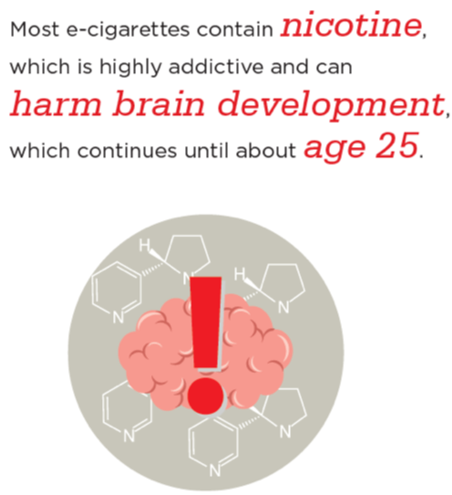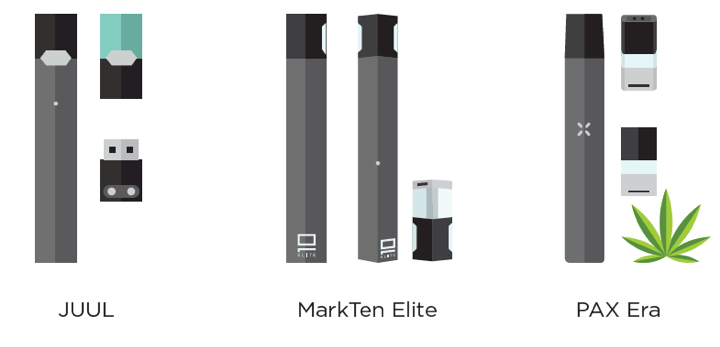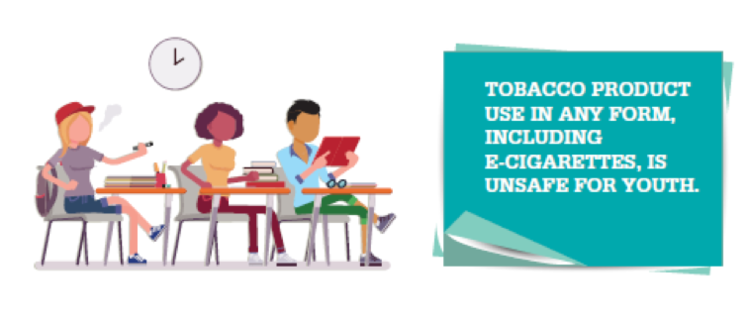Frontline Blog
Let schools be places for learning—not “JUULing”
September 2018
By Brian A. King, PhD, MPH, Deputy Director for Research Translation, Office on Smoking and Health, Centers for Disease Control and Prevention
Remember your high school bathroom? If it was anything like mine, the bathroom was a fairly foul-smelling place that you wanted to leave as quickly as possible.
But things are changing. Kids are flocking to school bathrooms across the country faster than the cafeteria on pizza day. School bathrooms have become places where students gather to socialize and use e-cigarettes—in particular, e-cigarettes shaped like USB flash drives that deliver a high level of nicotine.

Using e-cigarettes in bathrooms is so common, in fact, that students are calling school bathrooms “the JUUL room” after JUUL, the top selling brand of e-cigarette in the U.S. Owing to the popularity of JUUL, other e-cigarette manufacturers are making look-alike products such as PHIX, SMOK, myBlu, and MarkTen Elite.
But regardless of the product, or what you call it, it’s an e-cigarette. In 2017, 2.1 million U.S. middle and high school students reported current use of e-cigarettes. This is a public health concern because the use of any tobacco product—whether smoked, smokeless, or electronic —among young people is unsafe. Most of these products contain nicotine, which is highly addictive. The U.S. Surgeon General has concluded that nicotine exposure during adolescence can
harm the developing brain—which continues to develop until about age 25. Specifically,
nicotine exposure during adolescence impacts learning, memory, and attention and
primes the brain for addiction. In addition to nicotine, the aerosol that users inhale and then exhale into the environment can expose both themselves and bystanders to other harmful substances, including heavy metals, volatile organic compounds, and ultrafine particles that can be inhaled deep into the lungs.
Many students say their e-cigarettes do not contain nicotine, but sales data cast doubt on youths’ self-reported understanding of what’s in these products. A CDC study of retail scanner data found that 99% of all e-cigarettes sold in U.S. convenience stores, supermarkets, and other similar outlets contain nicotine. Many of these products also come in kid-friendly flavors. In addition to making e-cigarettes more appealing to young people, some of the chemicals used to make certain flavorings may also have health risks. For example, although some of these flavorings may be safe to eat, we don’t know the long term health risks of inhaling them deep into the lungs. The gut can handle a lot more than the lungs, and the gut also has a clear exit strategy.
Further complicating the issue for parents and educators is that e-cigarettes can also be used to deliver marijuana and other drugs. USB flash drive-shaped devices such as the Pax Era closely resemble JUUL, but deliver marijuana without the characteristic smell of marijuana smoke.

According to results from a survey conducted in April 2018 by the Truth Initiative, nearly one-fifth of middle and high school students have seen JUUL used in school. And although sales of e-cigarettes to minors are prohibited by federal law, 3 out of 4 kids who had used JUUL said they obtained the device from a physical retail location.
Furthermore, students may have low awareness of the addictive potential of these products: 63% of JUUL users ages 15-24 did not know that the product always contains nicotine. JUUL not only always contains nicotine, it always contains a lot of nicotine—according to the manufacturer, each liquid refill “pod” contains as much nicotine as an entire pack of regular cigarettes. Each pod can deliver about 200 puffs for the user, or even more depending on how hard the user inhales. These products also use nicotine salts, rather than the freebase nicotine used in most other e-cigarettes and tobacco products. These nicotine salts allow particularly high levels of nicotine to be inhaled more easily and with less irritation than free base nicotine. This is of particular concern for people who have never used nicotine before, such as youth, because it could make it easier for them to initiate the use of nicotine through these products.
However, stronger and more efficient delivery of nicotine in e-cigarettes may also increase the products’ acceptability as a complete substitute for cigarettes among adult smokers. This could be positive for these individuals given that e-cigarettes have the potential to benefit adult smokers who are not pregnant if used as a complete substitute for regular cigarettes and other smoked tobacco products. But the science on the effectiveness of e-cigarettes for cessation is still uncertain, and we still have more to learn about their long-term health risks.

Regardless of any potential benefit that e-cigarettes may have among adult smokers using them to successfully quit, unless we take aggressive steps to protect kids, these highly potent products also risk exposing a new generation of teens to nicotine. Media reports document that educators and parents across the country are struggling to deal with teen e-cigarette use and nicotine exposure. Out of 53 suspensions last year at Northgate High School in Walnut Creek, California, 40 were for e-cigarette devices. And a high school administrator in Jamestown, North Dakota suffered from symptoms of nicotine poisoning after confiscating an e-cigarette from a student.
This emerging public health issue represents an important opportunity for city and county health officials to partner with counterparts in education and to help parents, educators, health care providers, and other youth influencers protect our nation’s kids from this completely preventable health risk. Health departments across the country are forging new partnerships in creative ways. For example:
- North Carolina’s Department of Public Instruction and Division of Public Health teamed up to write a letter to all local school superintendents and charter school directors about use of e-cigarettes in schools—a violation of the state’s tobacco-free school policy—and linking to resources from CDC and others.
- Minnesota’s Commissioners of Health and Education co-wrote a letter to school administrators alerting them to the issue and sharing a toolkit with information, resources, and free curricula to use in schools.
To help facilitate this type of dialogue and inform key partners, CDC offers easy to understand, visually appealing resources that explain what these products are, highlight their risks for young people, and provide action steps to protect kids. Here are some simple steps you can take today to get informed and spread the word:
- Send your local school district colleagues our infographic about E-cigarettes Shaped Like USB Flash Drives: Information for Parents, Educators, and Health Care Providers and our Parent Tip Sheet on how to talk to youth about e-cigarettes.
- Share the new web content, “Quick Facts on the Risks of E-cigarettes for Kids, Teens, and Young Adults.” For information about how to syndicate this information on your organization’s website, go to the Public Media Health Library.
- Like, share, or retweet CDC’s new interactive, creative content on Facebook and Twitter. The dynamic posts show how e-cigarettes could be hiding in schools, even in lockers.
- Share the “Any Volunteers? The Risk of E–Cigarettes for Young People” video on your social media channels or embed the video on your website.
In summary, as city and county health officials, you can play a critical role to help parents and educators recognize e-cigarette products, know their risks, and to take action to protect our nation’s kids from this preventable health risk. Schools are for learning, and school bathrooms aren’t for JUULing. Every student deserves to learn in a healthy and safe environment.